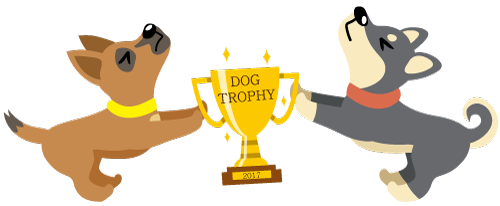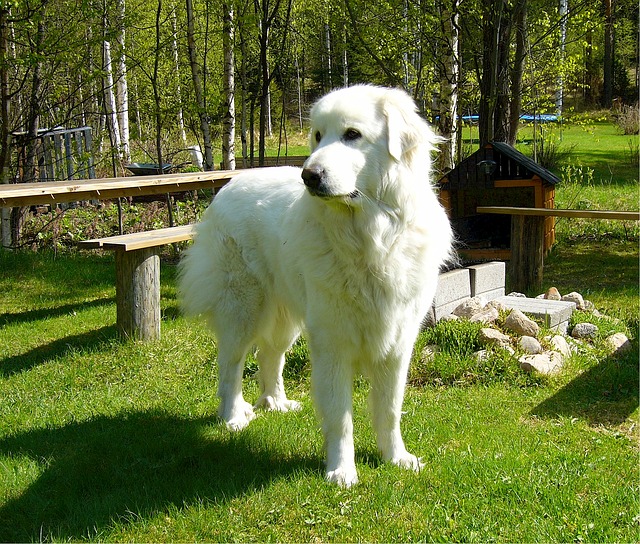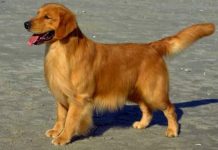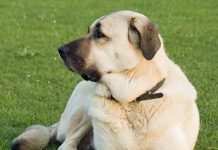The Great Pyrenees dog was mostly used in the territories of Spain and France to guard the property from bears and wolves and as aiding in livestock.
Description
– Male dogs of this breed can reach a height of 80 centimeters
– Female dogs of this breed can reach a height of up to 72 centimeters
– Male dogs of this breed can reach a weight of up to 60 kg
– Female dogs of this breed can reach a weight of up to 45 kg
– The lifespan of this dog breed can be 14 years.
These cheerful dogs are the perfect complement to a home where there are children, as well as active family members, who will be able to take their dogs with them for any adventure.
Also, any family that has a spacious backyard can definitely afford an extra family member – the Pyrenean Mountain Dog.
These dogs are extremely large and have thick hair, which has helped them through the coldest winters throughout history, but despite this, they do not require much care, but only occasional combing.
Do not expect your dog to always be ready for the show because of its beauty, as it enjoys rolling on different surfaces, especially in the snow, though it does not even escape when it is muddy, which is why their white hair is often soiled.
What characterizes them is a very characteristic, many strange, barking, by which they will at least be remembered throughout your surroundings.
They have extremely strong immunity and rarely get sick, which is why they should not be taken as often to the vet, but under no circumstances should you skip regular vaccines, which will be notified to you by the vet. The pain that can occur in these dogs is hip dysplasia, which occurs precisely because of their size.
Although cumbersome, Great Pyrenees Dogs have an extremely light and elegant gait, with their heads proudly worn and, when walking with the owner, are extremely obedient, and thus give the impression of a respected owner from a high stock.
The head of the Pyrenean mountain dogs is flat on the side, while the nape of the neck is just noticeable and the skull in the back is pointed. The chews are relatively relaxed and, as a rule, cover the lower jaw, and may be either black or fringed with black. The palate is also black, as is the nasal mushroom. The eyes are generally small, slightly sloping, with black edges and amber brown pupil.
The dog’s tail is extremely long and lowered during the inactive period, and it is advisable to be hooked at the tip. During intrigue or any type of activity, the tail of the Great Pyrenees Dog should be tucked in the back.
Pyrenean mountain dogs are mostly white in color, though some specimens may also show red or gray hues. What distinguishes Great Pyrenees Dogs from the Golden Retrievers and Labradors is the extremely thick and long hair, which must be exclusively straight, possibly slightly wavy on the tail and neck.
Consequently, dogs of this breed should be combed and brushed at least once a day to remove excess hair and bathed once to 2 times a month, although more frequent bathing during the summer is advisable. Although most owners enjoy showing meticulous and well-groomed dogs, in the case of Pyrenean mountain dogs, licking is a waste of time.
Temperament
Although at first glance they may look scary because of their size, Pyrenean Mountain Dogs are actually very friendly to humans and other animals, to whom they will always have a protective attitude, because it simply is in nature.
Pyrenean mountain dogs are very sociable and are especially good with children, which most owners even entrust to dogs while playing in the yard. No matter how amazing it may sound, these dogs are not aggressive or reserved even to strangers, unless there is no one in the house, and they feel that the stranger is trying to usurp their territory.
However, even at these moments, they will growl rather than attack. They can also be repulsive of other units that bring their owners to mate because they are extremely territorial, and they may be scared that another dog is trying to take their place.
Great Pyrenees dogs are extremely active by nature and, consequently, the fact that they are extremely large is not recommended for keeping inside the house, especially the apartment. Their happy life and proper development require a spacious yard where dogs can feel free, and if you cannot provide it, do not even bother introducing it to your family.
If you are worried about how the dog will react if it is outside, it does not. These dogs have extremely strong immunity, which is why they are very rarely ill, and they are also resistant to all weather conditions, as well as sudden changes in temperatures.
However, it is a fact that these dogs are able to lather in periods of high heat, and then it should be bathed more often, and, if you can, lead somewhere where it can swim smoothly and safely. Speaking of which, like other dogs, Great Pyrenees dogs must always have a large bowl of freshwater available.
Also, these dogs are known to be dogs that eat a lot and should be consulted with the veterinarian about the exact dosage from the beginning, although most food manufacturers on the pack indicate how much and how to feed the Pyrenean Sheepdog.
As far as dressage is concerned, you shouldn’t have much trouble with a Pyrenean mountain dog, although in this case, it is advisable to start training while the dog is still small in order to give better training and not to try more aggressive and more stringent measures, arm yourself with patience.
Health
Their thick hair needs to be brushed at least once a day and bathed up to 2 times a month. This is the dog that will be happiest in the yard, where it will have the opportunity to move as much as it wants. They tolerate cold, but during the summer months, they need to be protected from the sun so as not to suffer the effects of a possible heatstroke. These breed of dogs love water but also rolling in mud, so this dog can almost never be completely clean.
They have extremely strong immunity, very rarely get sick, and are among the healthiest breeds. They are resistant to almost all diseases, however, due to their size, the disease that can possibly occur is hip dysplasia. Keep in mind that this dog needs a large amount of food and that purchasing this breed in our country can be a great investment because in our country this breed is only gaining in popularity.
Care
The trimming should be thorough so that the fur looks nice and fluffy. You should brush it once or twice a day to remove dead and weak hair. And in the period of mitigation, brushing should be more frequent.
Feeding
It is logical that when it comes to such a dog, be prepared to spend a good portion of your money on his diet. Whether it’s granules or homemade food, this breed of dog eats a lot. This breed of dog has no problem with home-cooked food.
Puppies
Great Pyrenees puppies should be fed with high-quality dog food to gain immunity. These puppies are durable and can be bred from an early age and outdoors.
History
Pyrenean mountain dogs originated in Asia. Their further ancestor was the Tibetan Dog, and then it was crossed with different Asian races until a satisfactory breed of the Great Pyrenees was created.
Pyrenean mountain dogs were first used to guard the herd and defend against wild predators such as wolves and bears.
In addition to the herds, they also guarded the households and their owners, and the owners designed a preventative barbed necklace, which the Pyrenean Mountain Dogs non-stop wore, to provide some protection from wolves and bears.
For the first time, the breed of Pyrenean mountain dogs was mentioned in written records in the 17th century, and as pets, with no obligation to keep pasture, began to be used only in the new millennium, although it is known that French nobles kept them in their yards. during the Middle Ages, during which they were most widespread in France as well as in Spain.





